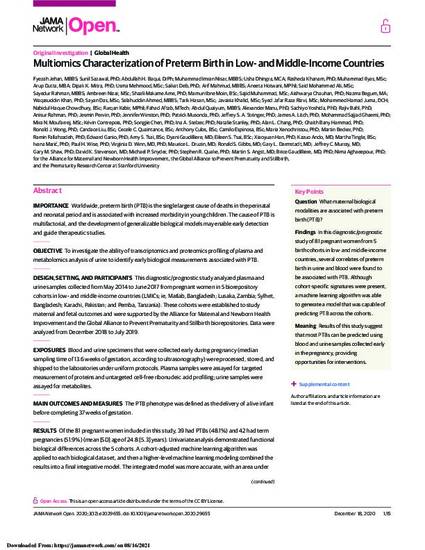
Importance: Worldwide, preterm birth (PTB) is the single largest cause of deaths in the perinatal and neonatal period and is associated with increased morbidity in young children. The cause of PTB is multifactorial, and the development of generalizable biological models may enable early detection and guide therapeutic studies.
Objective: To investigate the ability of transcriptomics and proteomics profiling of plasma and metabolomics analysis of urine to identify early biological measurements associated with PTB.
Design, Setting, and Participants: This diagnostic/prognostic study analyzed plasma and urine samples collected from May 2014 to June 2017 from pregnant women in 5 biorepository cohorts in low- and middle-income countries (LMICs; ie, Matlab, Bangladesh; Lusaka, Zambia; Sylhet, Bangladesh; Karachi, Pakistan; and Pemba, Tanzania). These cohorts were established to study maternal and fetal outcomes and were supported by the Alliance for Maternal and Newborn Health Improvement and the Global Alliance to Prevent Prematurity and Stillbirth biorepositories. Data were analyzed from December 2018 to July 2019.
Exposures: Blood and urine specimens that were collected early during pregnancy (median sampling time of 13.6 weeks of gestation, according to ultrasonography) were processed, stored, and shipped to the laboratories under uniform protocols. Plasma samples were assayed for targeted measurement of proteins and untargeted cell-free ribonucleic acid profiling; urine samples were assayed for metabolites.
Main Outcomes and Measures: The PTB phenotype was defined as the delivery of a live infant before completing 37 weeks of gestation.
Results: Of the 81 pregnant women included in this study, 39 had PTBs (48.1%) and 42 had term pregnancies (51.9%) (mean [SD] age of 24.8 [5.3] years). Univariate analysis demonstrated functional biological differences across the 5 cohorts. A cohort-adjusted machine learning algorithm was applied to each biological data set, and then a higher-level machine learning modeling combined the results into a final integrative model. The integrated model was more accurate, with an area under the receiver operating characteristic curve (AUROC) of 0.83 (95% CI, 0.72-0.91) compared with the models derived for each independent biological modality (transcriptomics AUROC, 0.73 [95% CI, 0.61-0.83]; metabolomics AUROC, 0.59 [95% CI, 0.47-0.72]; and proteomics AUROC, 0.75 [95% CI, 0.64-0.85]). Primary features associated with PTB included an inflammatory module as well as a metabolomic module measured in urine associated with the glutamine and glutamate metabolism and valine, leucine, and isoleucine biosynthesis pathways.
Conclusions and Relevance: This study found that, in LMICs and high PTB settings, major biological adaptations during term pregnancy follow a generalizable model and the predictive accuracy for PTB was augmented by combining various omics data sets, suggesting that PTB is a condition that manifests within multiple biological systems. These data sets, with machine learning partnerships, may be a key step in developing valuable predictive tests and intervention candidates for preventing PTB.
Available at: http://works.bepress.com/xiaoyuan-han/56/

See original publication for all author affiliations: https://doi.org/10.1001/jamanetworkopen.2020.29655